The diversity of living organisms on Earth is immense, with the planet teeming with countless forms of life, each adapted to its environment in unique ways. Earth’s regions, especially those rich in biodiversity, like India, are home to a vast array of organisms, ranging from microscopic entities to large animals and plants. These organisms vary widely in their shapes, sizes, modes of nutrition, reproductive strategies, and habitats. This immense variety has led scientists to classify living organisms into different kingdoms, orders, and classes. Among these, the Kingdom of Fungi is particularly fascinating due to its unique characteristics and significant ecological roles.
Table of Contents
Introduction to Fungi
The term “fungi” (singular: fungus) refers to a group of eukaryotic organisms that includes microorganisms such as molds, yeasts, and the more familiar mushrooms. Unlike plants, fungi lack chlorophyll, which means they cannot perform photosynthesis to produce their food. Instead, they obtain nutrients by breaking down and absorbing organic matter, a trait that distinguishes them from other kingdoms such as Plantae, Animalia, and certain Protists.
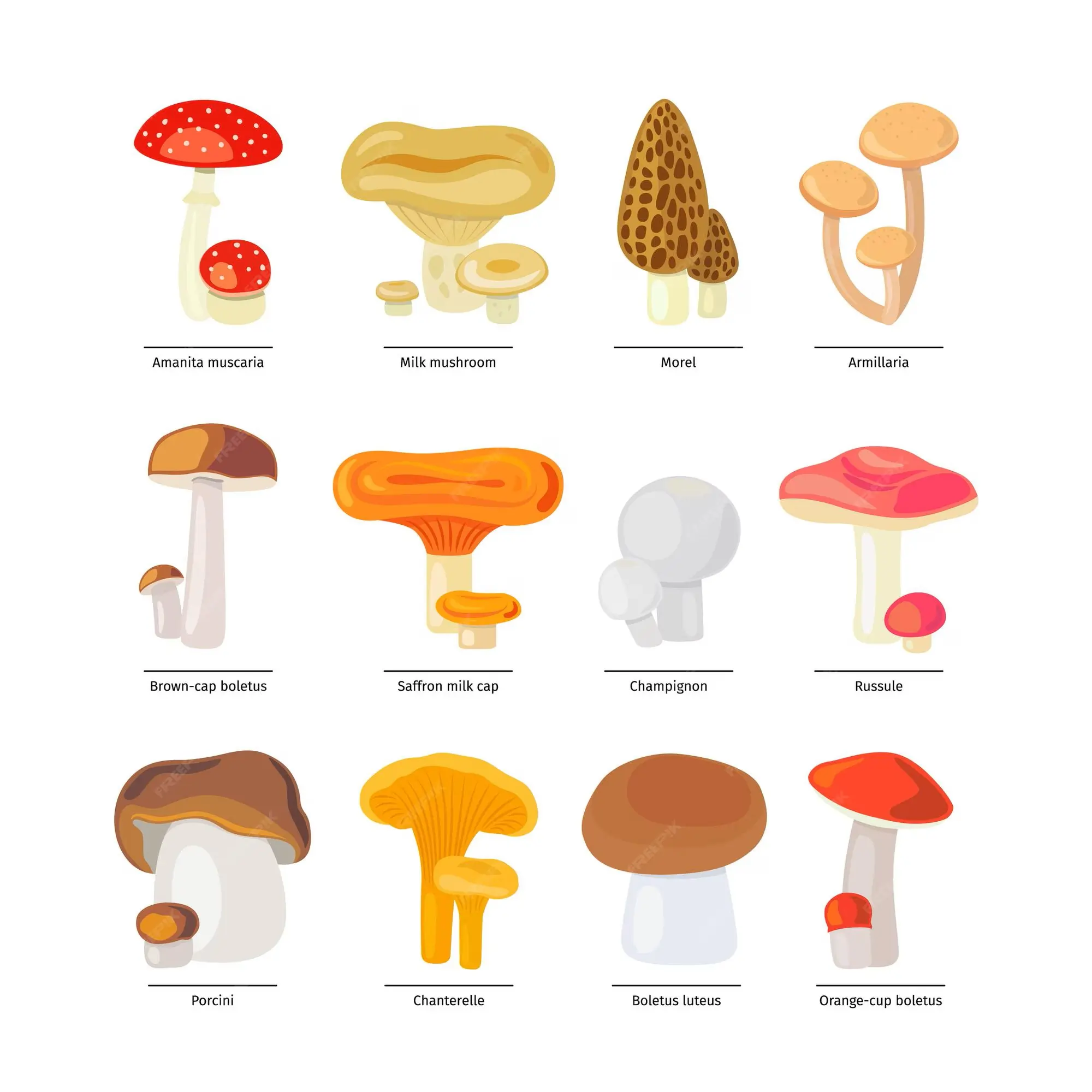
Fungi are found in a wide range of environments, from the dark, damp corners of your home to the forest floor, where they play a crucial role in decomposing dead organic matter. The appearance of dark spots on bread left outside for several days, the growth of mushrooms on forest floors, and the yeast cells used in brewing beer and baking bread are all examples of fungi in action. Moreover, fungi are also responsible for various skin infections and other parasitic diseases in humans and animals.
Fungi, along with bacteria, are the principal decomposers in ecosystems. They break down complex organic matter into simpler compounds, thereby recycling essential elements like carbon, nitrogen, and phosphorus back into the environment. This recycling process is vital for maintaining the balance of ecosystems and supporting the growth of plants and other organisms.
Characteristics of Fungi
Fungi exhibit a wide range of characteristics that make them unique among living organisms. Some of the key characteristics include:
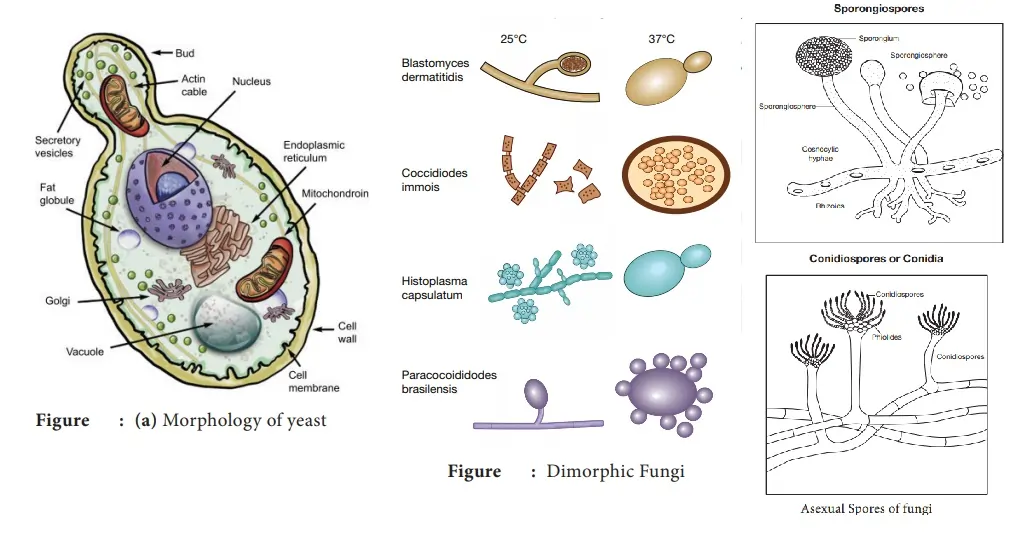
- Eukaryotic Nature: Fungi are eukaryotic organisms, meaning their cells contain a true nucleus and other membrane-bound organelles. This distinguishes them from prokaryotic organisms like bacteria.
- Non-Vascular: Unlike plants, fungi lack a vascular system. They do not have structures like xylem and phloem to transport water and nutrients.
- Heterotrophic: Fungi are heterotrophic, meaning they cannot produce their food through photosynthesis. Instead, they obtain nutrients by absorbing organic matter from their environment.
- Lack of Chlorophyll: Fungi do not contain chlorophyll, the green pigment found in plants that is essential for photosynthesis. This lack of chlorophyll means fungi must obtain their nutrients from external sources.
- Cell Wall Composition: The cell walls of fungi are composed of chitin, a complex polysaccharide also found in the exoskeletons of insects. This gives the fungal cell wall its strength and rigidity, protecting the cell from environmental stressors such as drying out and predation.
- Reproduction: Fungi reproduce both sexually and asexually through the production of spores. These spores can be formed in specialized structures like sporangia, conidia, or ascocarps, depending on the type of fungus.
- Hyphae and Mycelium: Most fungi are composed of long, thread-like structures called hyphae. These hyphae interweave to form a dense network known as mycelium, which is the main vegetative part of the fungus.
- Environmental Preferences: Fungi thrive in moist and warm environments. They are commonly found in damp areas such as soil, decaying organic matter, and on surfaces like bread and fruit.
- Biosynthesis of Chitin: The biosynthesis of chitin in fungi is a crucial process that helps in maintaining the integrity of the cell wall, allowing fungi to withstand various environmental challenges.
- Lack of Embryonic Stage: Unlike animals, fungi do not have an embryonic stage in their life cycle. They develop directly from spores, which can be either sexual or asexual.
- Pheromones and Sexual Reproduction: Fungi produce compounds called pheromones, which play a role in sexual reproduction by attracting compatible mating types.
Structure of Fungi
The structure of fungi varies depending on whether they are unicellular or multicellular. The primary structural components of fungi include:
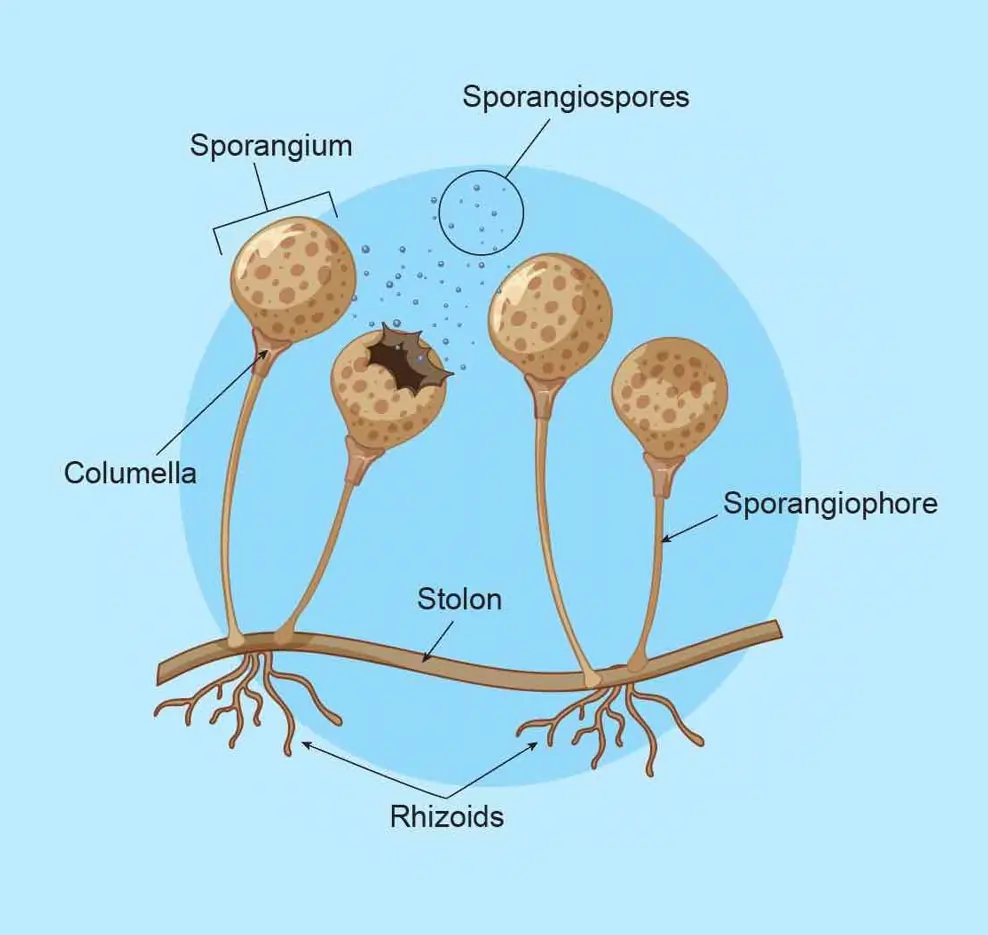
- Cell Wall: Fungi have a cell wall composed of polysaccharides like chitin, which provides structural support and protection.
- Hyphae: In multicellular fungi, the body consists of hyphae, which are long, thread-like filaments. These hyphae can be septate (with cross-walls) or coenocytic (without cross-walls).
- Mycelium: The network of hyphae forms the mycelium, which is the vegetative part of the fungus. The mycelium can extend over a large area and plays a crucial role in nutrient absorption.
- Sporangium: A structure in which spores are produced. In some fungi, the sporangium is a simple sac-like structure, while in others, it is more complex.
- Spores: Fungi reproduce via spores, which can be asexual or sexual. These spores are often dispersed by wind, water, or animals, allowing fungi to colonize new environments.
- Nucleus: The nucleus of fungal cells contains chromatin and is involved in controlling the cell’s activities, including growth and reproduction.
Classification of Fungi
Fungi are classified into several groups based on their reproductive structures and spore formation. The main classes of fungi include:
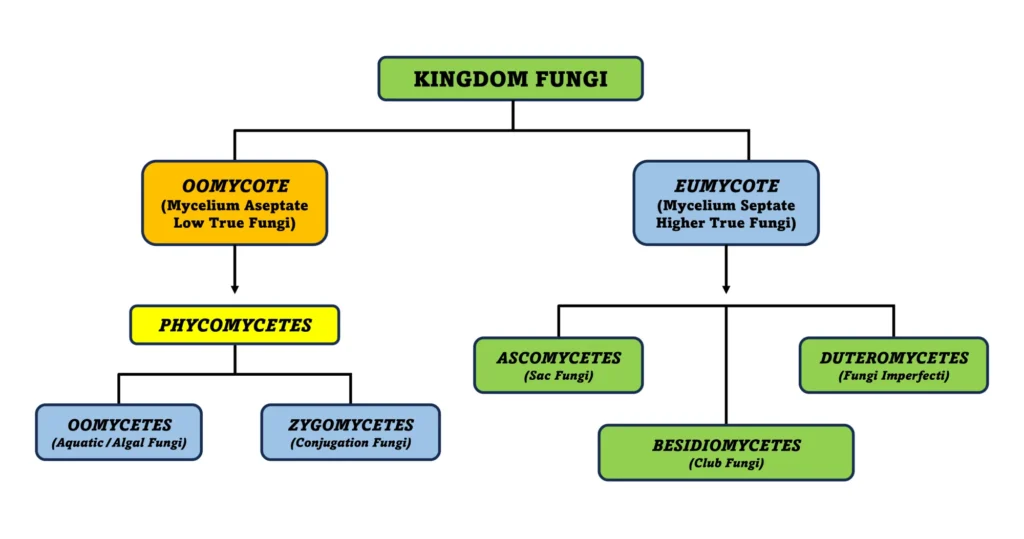
- Ascomycetes: Also known as sac fungi, these fungi are characterized by the formation of sexual spores called ascospores within a sac-like structure called an ascus. Asexual reproduction occurs through conidia. Examples include Saccharomyces (yeast) and Gibberella.
- Basidiomycetes: Known as club fungi, these fungi produce sexual spores externally on a club-shaped structure called a basidium. The sexual spores are called basidiospores. Common examples include mushrooms like Amanita and Agaricus.
- Zygomycetes: These fungi form sexual spores called zygospores through the fusion of two similar cells. Asexual reproduction occurs through sporangiospores. Rhizopus (black bread mold) and Mucor are typical examples.
- Deuteromycetes: Also known as imperfect fungi, these fungi do not have a known sexual stage in their life cycle. Asexual reproduction occurs through conidia. Many human and animal pathogens belong to this class, including Candida, Cryptococcus, Trichophyton, and Histoplasma.
Classification Based on Nutrition
Fungi can also be classified based on their mode of nutrition:
- Saprophytic Fungi: These fungi obtain nutrients from dead and decaying organic matter. They play a crucial role in decomposition and nutrient recycling. Examples include Penicillium, Rhizopus, and Mucor.
- Parasitic Fungi: Parasitic fungi derive their nutrients from living hosts, often causing diseases in the host organisms. They can be further classified into:
- Endoparasites: These fungi live inside the host’s body.
- Ectoparasites: These fungi live on the surface of the host. Examples include Candida and Trichophyton.
- Mutualistic Fungi: These fungi form mutually beneficial relationships with other organisms. An example is mycorrhizal fungi, which form associations with plant roots, helping the plant absorb nutrients while receiving carbohydrates in return.
Reproduction in Fungi
Fungi reproduce through various methods, both sexual and asexual. The reproductive strategies of fungi are diverse and adapted to their environments:
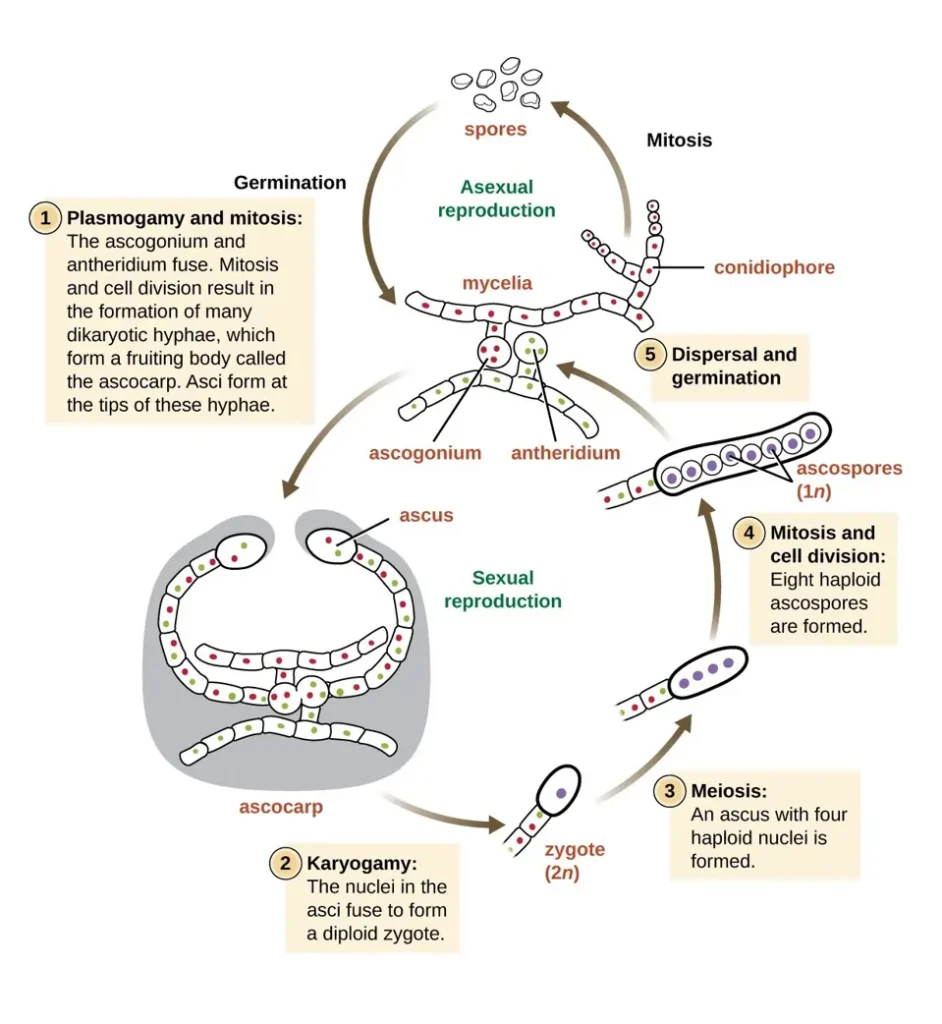
- Asexual Reproduction: This occurs through the production of spores such as conidia, zoospores, or sporangiospores. Asexual reproduction allows fungi to rapidly colonize new environments.
- Vegetative Reproduction: Fungi can also reproduce vegetatively through methods like budding, fission, and fragmentation.
- Sexual Reproduction: Sexual reproduction in fungi involves the fusion of compatible hyphae to form specialized structures like ascospores, basidiospores, or zygospores. In some fungi, a unique stage called the dikaryophase occurs, where two haploid nuclei coexist in the same cell without fusing, leading to the formation of diploid cells later.
Uses of Fungi
Fungi have numerous applications and play essential roles in various industries and ecological processes:
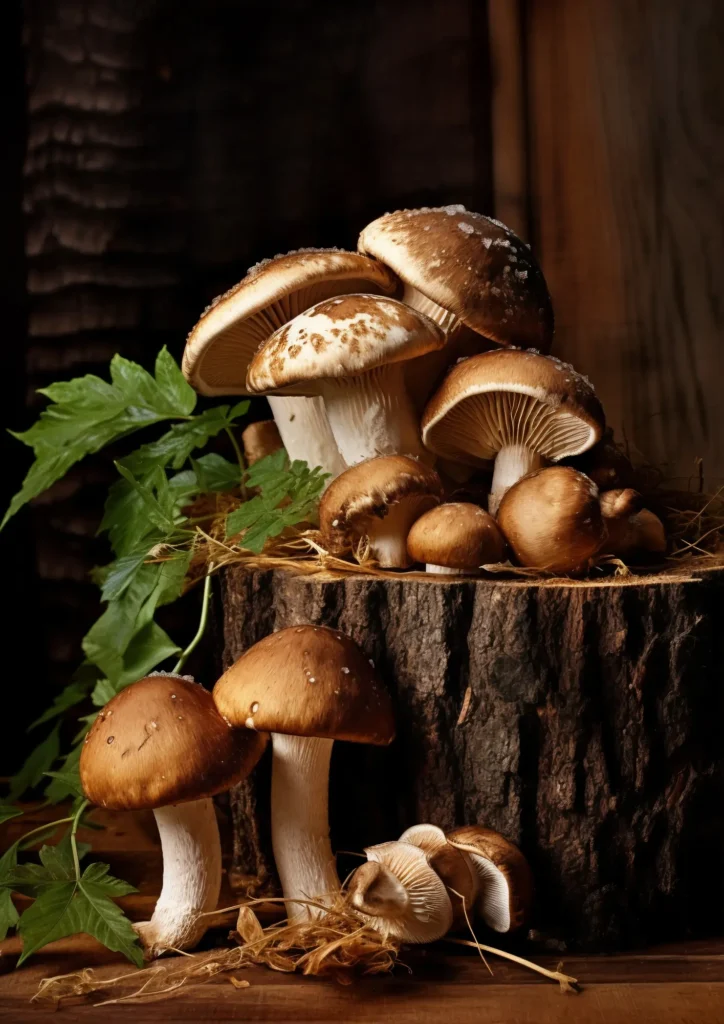
- Decomposition and Nutrient Cycling: Fungi are vital decomposers in ecosystems, breaking down dead organic matter and recycling nutrients back into the soil. This process is crucial for the health of ecosystems, as it ensures the availability of essential nutrients for plants and other organisms.
- Food Industry: Fungi are used in the production of various foods and beverages. Yeast (Saccharomyces cerevisiae) is essential in baking and brewing, while edible mushrooms like Agaricus bisporus are cultivated for consumption. Fermented products like soy sauce and tempeh also rely on fungal fermentation.
- Medicine: Fungi are a source of important pharmaceuticals. The antibiotic Penicillin, derived from the fungus Penicillium, revolutionized medicine by providing an effective treatment for bacterial infections. Other medically significant fungi include Aspergillus (used in producing statins) and Cyclosporine (an immunosuppressant used in organ transplantation).
- Biocontrol Agents: Fungi are used in agriculture as biocontrol agents to manage pests and diseases. Beauveria bassiana is an example of a fungus used to control insect pests, reducing the need for chemical pesticides.
- Bioremediation: Some fungi have the ability to degrade environmental pollutants, making them useful in bioremediation efforts to clean up contaminated soils and water.
- Research and Biotechnology: Fungi are widely used in scientific research and biotechnology. The model organism Neurospora crassa has been instrumental in understanding genetic processes, while yeast is used in genetic engineering and industrial biotechnology.
- Production of Enzymes and Organic Acids: Fungi produce a wide range of enzymes and organic acids used in various industrial processes, including the production of biofuels, food processing, and waste treatment.
Informative Table Related to Fungi
Fungi are incredibly diverse organisms that play a significant role in ecosystems and human industries. Below is a detailed table summarizing the key aspects of fungi, including their characteristics, structure, classification, reproduction methods, and uses.
| Aspect | Details |
|---|---|
| Kingdom | Fungi |
| Characteristics | – Eukaryotic organisms – Non-vascular and heterotrophic – Lack chlorophyll and cannot perform photosynthesis – Cell walls composed of chitin – Reproduce via spores – Thrive in moist and warm environments – Exhibit sexual and asexual reproduction |
| Structure | – Cell Wall: Composed of polysaccharides and chitin – Hyphae: Long, thread-like structures – Mycelium: Network of hyphae – Sporangium: Spore-producing structure – Nucleus: Contains chromatin strings |
| Classification | – Ascomycetes: Sac fungi; produce ascospores in an ascus (e.g., Saccharomyces, Gibberella) – Basidiomycetes: Club fungi; produce basidiospores on a basidium (e.g., Amanita, Agaricus) – Zygomycetes: Produce zygospores (e.g., Rhizopus, Mucor) – Deuteromycetes: Imperfect fungi; reproduce asexually through conidia (e.g., Candida, Cryptococcus, Trichophyton) |
| Nutritional Modes | – Saprophytic: Decompose dead organic matter (e.g., Penicillium, Rhizopus) – Parasitic: Obtain nutrients from living hosts, causing diseases (e.g., Candida, Trichophyton) – Mutualistic: Form beneficial relationships with other organisms (e.g., Mycorrhizal fungi) |
| Reproduction | – Asexual: Through conidia, zoospores, sporangiospores – Vegetative: Through budding, fission, fragmentation – Sexual: Formation of ascospores, basidiospores, or zygospores – Dikaryophase: Intermediate stage in some fungi before diploid cell formation |
| Uses | – Decomposition: Recycling of nutrients in ecosystems – Food Industry: Production of bread, beer, and edible mushrooms – Medicine: Source of antibiotics like penicillin – Biocontrol Agents: Used in agriculture to control pests – Bioremediation: Degradation of environmental pollutants |
Conclusion
Fungi are a diverse and fascinating group of organisms that play essential roles in ecosystems and human industries. Their ability to decompose organic matter, form mutualistic relationships with plants, and produce medically important compounds highlights their significance in nature and society. Understanding the characteristics, classification, and uses of fungi not only deepens our appreciation of biodiversity but also underscores the importance of preserving these vital organisms in the face of environmental change.
Related Articles
- Kingdom Fungi: A Comprehensive Exploration
- Protozoans: Structure, Classification, Characteristics, And Examples
- Slime Moulds: A Comprehensive Overview
- Euglenoid: The Unique Plant-Animal Hybrid
- Dinoflagellates: The Whirling Protists of the Oceans
- Chrysophytes: A Detailed Exploration Of Their Classification, Characteristics, & Significance
- Eubacteria: Structure, Characteristics, Classification, And Types
- Archaebacteria: A Glimpse Into Ancient Life Forms
- Kingdom Protista: A Diverse Group Of Single-Celled Eukaryotes
- The Diversity And Importance Of Bacteria: Archaebacteria And Eubacteria
- Kingdom Monera: The World Of Bacteria
- The Evolution Of Biological Classification Systems
- Understanding Taxonomy, Taxonomic Categories And Hierarchy
- The Diversity Of Life: Understanding Taxonomy, Classification, And Systematics
Frequently Asked Questions (FAQs) About Fungi
What are fungi?
Fungi are a group of eukaryotic organisms that include microorganisms such as yeasts, molds, and more complex forms like mushrooms. Unlike plants, fungi lack chlorophyll and cannot perform photosynthesis. They obtain nutrients by decomposing organic matter or forming parasitic or mutualistic relationships with other organisms.
How do fungi differ from plants?
Fungi differ from plants in several key ways. Fungi lack chlorophyll and therefore cannot perform photosynthesis. Instead, they obtain nutrients through absorption. Additionally, fungal cell walls are composed of chitin, while plant cell walls are made of cellulose. Fungi are also non-vascular and do not have structures like xylem and phloem.
What is the role of fungi in ecosystems?
Fungi play a crucial role in ecosystems as decomposers. They break down dead organic matter, recycling essential nutrients like carbon, nitrogen, and phosphorus back into the environment. This process supports plant growth and helps maintain the balance of ecosystems.
How do fungi reproduce?
Fungi reproduce through both sexual and asexual methods. Asexual reproduction occurs via spores such as conidia, zoospores, or sporangiospores. Sexual reproduction involves the formation of specialized spores like ascospores, basidiospores, or zygospores. Some fungi also reproduce vegetatively through budding, fission, or fragmentation.
What are the different types of fungi?
Fungi are classified into several groups based on their reproductive structures and spore formation. The main types include:
- Ascomycetes: Known as sac fungi, they produce spores in a sac-like structure called an ascus (e.g., Saccharomyces).
- Basidiomycetes: Known as club fungi, they produce spores on a structure called a basidium (e.g., Agaricus).
- Zygomycetes: Produce spores called zygospores through the fusion of similar cells (e.g., Rhizopus).
- Deuteromycetes: Known as imperfect fungi, they reproduce asexually and have no known sexual stage (e.g., Candida).
What are mycorrhizal fungi?
Mycorrhizal fungi form mutualistic relationships with plant roots, helping plants absorb nutrients like phosphorus and nitrogen from the soil. In return, the fungi receive carbohydrates from the plant. This symbiotic relationship enhances plant growth and resilience.
What is the importance of fungi in medicine?
Fungi have a significant impact on medicine. One of the most famous examples is Penicillium, the fungus from which the antibiotic penicillin is derived. Penicillin revolutionized the treatment of bacterial infections. Fungi are also used to produce other important pharmaceuticals, such as statins (cholesterol-lowering drugs) and cyclosporine (an immunosuppressant used in organ transplantation).
How do fungi contribute to the food industry?
Fungi are essential in the food industry. Yeast (Saccharomyces cerevisiae) is used in baking to leaven bread and in brewing to ferment beer. Edible mushrooms like Agaricus bisporus are cultivated for food. Fungi also play a role in the production of fermented foods like soy sauce and tempeh.
What are the characteristics of fungal cell walls?
The cell walls of fungi are composed of chitin, a complex polysaccharide that provides strength and rigidity. This chitin structure is similar to that found in the exoskeletons of insects. Fungal cell walls protect the cell from environmental stressors, such as desiccation and predation.
How do fungi obtain their nutrients?
Fungi obtain nutrients through absorption. They secrete enzymes that break down complex organic matter into simpler compounds, which are then absorbed through their hyphae. Depending on their ecological role, fungi can be saprophytic (decomposing dead matter), parasitic (feeding on living hosts), or mutualistic (forming beneficial relationships with other organisms).
What are some examples of parasitic fungi?
Parasitic fungi derive nutrients from living hosts, often causing diseases. Examples include Candida (causes yeast infections in humans), Trichophyton (causes athlete’s foot), and Puccinia (causes rust diseases in plants). Parasitic fungi can be endoparasites (living inside the host) or ectoparasites (living on the surface of the host).
What is the mycelium?
The mycelium is the vegetative part of a fungus, consisting of a network of hyphae. This network can spread over large areas and is responsible for absorbing nutrients from the environment. The mycelium is often hidden from view, growing underground, or within decaying material.
How do fungi reproduce asexually?
Asexual reproduction in fungi occurs through the formation of spores such as conidia, sporangiospores, or zoospores. These spores are dispersed by wind, water, or animals, allowing the fungi to colonize new environments rapidly. Vegetative reproduction can also occur through budding (common in yeasts), fission, or fragmentation.
What are lichens, and how are they related to fungi?
Lichens are a symbiotic relationship between a fungus and a photosynthetic partner, usually an alga or cyanobacterium. The fungus provides structure and protection, while the photosynthetic partner produces food through photosynthesis. Lichens can colonize harsh environments, such as bare rocks, and are important indicators of air quality.
What are the economic impacts of fungi?
Fungi have both positive and negative economic impacts. On the positive side, they are used in the production of foods, beverages, and medicines. On the negative side, fungi can cause food spoilage and crop diseases, leading to significant economic losses in agriculture. For example, Aspergillus can contaminate stored grains, and Phytophthora infestans were responsible for the Irish potato famine.
How do fungi contribute to bioremediation?
Some fungi have the ability to degrade environmental pollutants, making them useful in bioremediation. These fungi can break down complex pollutants like hydrocarbons, pesticides, and heavy metals into less harmful substances. White rot fungi are particularly effective in breaking down lignin and other persistent organic pollutants.
What is the dikaryophase in fungi?
The dikaryophase is a unique stage in the life cycle of some fungi, where two haploid nuclei coexist in the same cell without fusing. This stage occurs after the fusion of two compatible hyphae but before the formation of a diploid cell. The dikaryophase is followed by the eventual fusion of the nuclei (karyogamy) and the formation of sexual spores.
What are some examples of mutualistic fungi?
Mycorrhizal fungi and lichens are examples of mutualistic fungi. Mycorrhizal fungi form beneficial relationships with plant roots, enhancing nutrient absorption, while lichens are a symbiosis between fungi and photosynthetic organisms. Another example is endophytic fungi, which live inside plant tissues and can enhance plant resistance to stress and pathogens.
How do fungi affect human health?
Fungi can have both beneficial and harmful effects on human health. Beneficial effects include the production of antibiotics like penicillin and cholesterol-lowering drugs like statins. Harmful effects include fungal infections like athlete’s foot (Trichophyton), candidiasis (Candida), and respiratory illnesses caused by inhaling fungal spores (Aspergillosis).
What are imperfect fungi?
Imperfect fungi (also known as Deuteromycetes) are fungi for which no sexual stage has been observed. They reproduce asexually through conidia. Many medically important fungi, such as Candida and Aspergillus, are classified as imperfect fungi because their sexual forms have not been discovered or do not occur under normal conditions.

